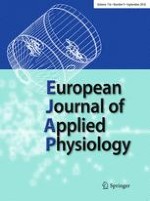01-09-2016 | Original Article
Cross-education of wrist extensor strength is not influenced by non-dominant training in right-handers
Published in: European Journal of Applied Physiology | Issue 9/2016
Login to get accessAbstract
Purpose
Cross-education of strength has been proposed to be greater when completed by the dominant limb in right handed humans. We investigated whether the direction of cross-education of strength and corticospinal plasticity are different following right or left limb strength training in right-handed participants.
Methods
Changes in strength, muscle thickness and indices of corticospinal plasticity were analyzed in 23 adults who were exposed to 3-weeks of either right-hand strength training (RHT) or left-hand strength training (LHT).
Results
Maximum voluntary wrist extensor strength in both the trained and untrained limb increased, irrespective of which limb was trained, with TMS revealing reduced corticospinal inhibition.
Conclusions
Cross-education of strength was not limited by which limb was trained and reduced corticospinal inhibition was not just confined to the trained limb. Critically, from a behavioral perspective, the magnitude of cross-education was not limited by which limb was trained.





